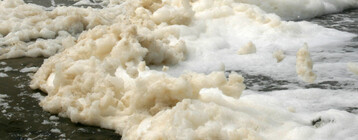Don't Eat Sea Foam: Town Issues Advisory After Latest PFAS Testing Results
JohnCarl McGrady •

The town issued an advisory on Friday instructing beachgoers not to eat Nantucket’s seafoam after potentially unreliable tests done on the foam showed extremely high levels of the so-called “forever chemicals” known as PFAS.
“Although there are currently no federal or state standards for PFAS levels in foam, the concentrations observed warrant caution,” the advisory reads in part. “The Town is planning additional sampling in late August 2025 to better understand PFAS presence in foam across the island.”
The advisory also instructs beachgoers to rinse off with fresh water as soon as possible if they come into contact with the foam.
“Because of the chemical structure of PFAS, foam can contain higher levels of these chemicals than the water it floats on,” the advisory continues. “While there are no standards for PFAS foam, taking precautions to reduce contact is important.”
While tested surface water samples collected from Nantucket’s beaches and ponds broadly contained little to no PFAS, foam samples collected from Madaket Harbor and Sesachacha Pond turned up far higher levels, in one case up to 30,000 ppt for a single PFAS compound. These results would be the highest levels of PFAS ever detected on Nantucket, but the lab that conducted the testing noted that many of the samples were unreliable and the tests should not be considered accurate. The actual levels of PFAS in Nantucket’s foam could be different from what the tests showed.
“Many of the results, in fact, all of the results from Sesachacha Pond, were qualified by the laboratory as not meeting their quality assurance criteria,” said Dr. Rebecca DeVries, the vice president at Eastern Research Group, the consulting firm hired by the town to help design, sample, and analyze the data. “This was largely because there was not sufficient volume in the sample.”
At this point, the health impacts of the contaminated foam are unclear.
“While we know PFAS are present, and likely at these higher levels, we aren’t certain of the exact concentration,” DeVries said. “Some of those qualifiers from the lab do indicate that the results could be biased high, so I just think that’s something to keep in mind.”
While the town works to conduct additional testing, beachgoers are advised to treat foam with caution.